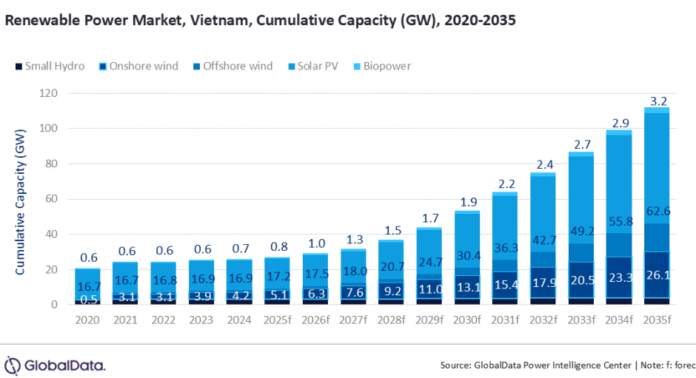Vietnam currently generates a large share of its electricity from coal- and gas-based thermal power plants, along with extensive use of hydropower.
However, due to environmental concerns and the effects of climate change, the Vietnamese government is increasingly shifting focus toward renewable energy sources. The country holds significant potential in wind, solar, and biomass energy, and renewable power generation is expected to play a key role in the future energy mix.
According to GlobalData, Vietnam’s cumulative renewable energy capacity is projected to reach 112.1 GW by 2035, growing at a compound annual growth rate (CAGR) of 14.3 percent from 2024 to 2035. Renewable power generation increased from 21.1 TWh in 2020 to 38.5 TWh in 2024, at a CAGR of 16 percent. This figure is expected to further rise to 179.6 TWh by 2035, reflecting a CAGR of 15 percent during the forecast period.
The government has introduced a number of supportive policies, including feed-in tariffs (FiTs) and the revised Power Development Plan 8 (PDP 8), to promote renewable energy development. While most of Vietnam’s hydropower potential has already been tapped, wind, solar, and biomass resources remain largely underutilized and offer substantial room for growth.
Hydropower, though currently a key source of electricity, poses risks due to Vietnam’s reliance on two annual monsoon seasons, which affect water availability. Low water levels can reduce hydropower output, increasing dependence on coal-based generation at a time when domestic coal reserves are diminishing. Oil and gas reserves are also running low, and Vietnam has transitioned from being a net exporter to a net importer of coal.
PDP 8 outlines a strategy for energy diversification through 2030, aiming to balance natural gas, coal, hydropower, solar, and wind sources while targeting net-zero emissions by 2050. To achieve these goals, the government is encouraging both foreign and private sector investments by promoting public-private partnerships (PPPs), implementing FiTs, and simplifying licensing processes.
However, large-scale energy projects, particularly in renewables and liquefied natural gas (LNG), face financing challenges due to regulatory uncertainty, a lack of bankable power purchase agreements (PPAs), and limited access to affordable long-term capital. The government is actively working to resolve these issues by introducing more favorable policies to attract investment and ensure sustainable energy development.
Several major renewable energy providers are actively contributing to Vietnam’s energy transition, focusing on wind, solar, and biomass projects. Trung Nam Group is one of the leading players, with a diversified portfolio across solar and wind energy. The company has developed large-scale projects, including a 450 MW solar plant in Ninh Thuan and a 151.95 MW wind farm, and continues to expand its capacity through new renewable ventures.
Bamboo Capital Group, through its subsidiary BCG Energy, has been aggressively investing in solar energy projects. It has developed rooftop solar systems for industrial and commercial users and aims to reach several gigawatts of solar capacity in the coming years. The company is also exploring offshore wind projects as part of its long-term strategy.
TTC Group has also emerged as a key player in the solar sector, particularly in southern Vietnam. It has been involved in building utility-scale solar farms and is expanding its presence in rooftop solar installations across industrial zones.
Vietnam Electricity (EVN), the state utility, plays a central role in the power sector and has been facilitating renewable energy integration into the national grid. EVN has signed multiple power purchase agreements (PPAs) with private renewable energy developers and is also investing in grid upgrades to support growing renewable capacity.
Foreign investors such as Thailand’s Gulf Energy, Japan’s JERA, and Singapore-based Sunseap Group have entered the Vietnamese market through joint ventures and acquisitions. These companies are focusing on wind and solar projects, with recent investments in both onshore and offshore wind farms, signaling confidence in Vietnam’s renewable energy potential.
Baburajan Kizhakedath

